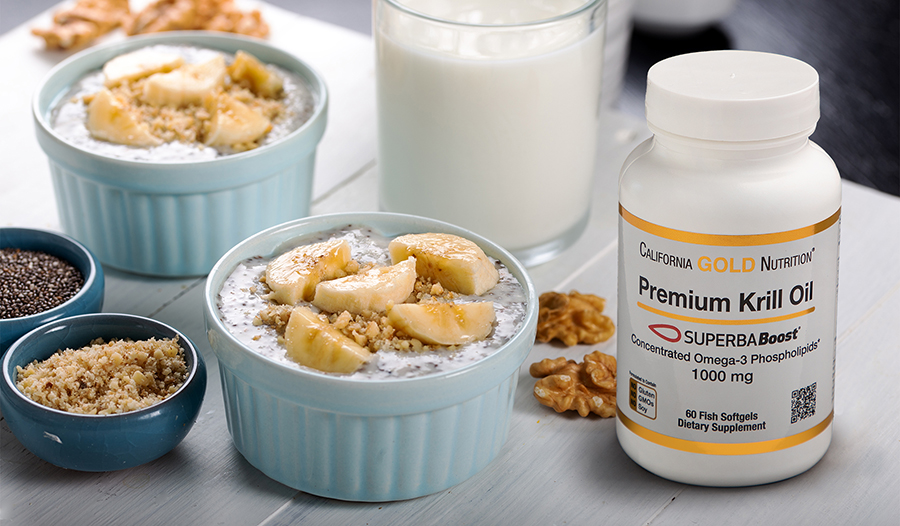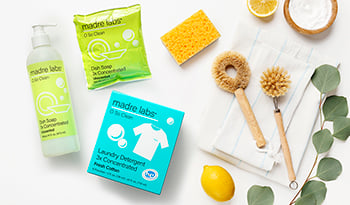How To Get More Sustainable, Eco-Friendly Omega-3s in Your Diet
DISCLAIMER:This blog does not intend to provide diagnosis...
- In this article:
- Why Care About Omega-3s?
- Why Care About Sustainability?
- Eating Sustainably
- What Are the Best Sustainable Options for Omega-3s?
- What About Fish Oils and Other Omega-3 Supplements?
- Takeaway

There is a natural overlap between caring for our bodies and caring for the environment. If you’re interested in living a healthy lifestyle, then you’re probably invested in creating healthy local, regional, and global environments for you and other living beings to explore and thrive in!
In my practice, I often discuss the ways we can heal and nurture our bodies with foods that are not only good for us, but also for the planet and our neighbors. That also means looking closely at the ways we use the earth to produce food, and how we give back. I encourage you to consider these important concepts when seeking sustainable ways to fit omega-3s into your daily routine.
Why Care About Omega-3s?
Omega-3s are essential to many vital bodily functions, from creating cell membranes and insulating nerves to acting as hormone-like agents controlling important functions like blood flow, inflammation, mood, and brain power. Omega-3 fatty acids are also critical for proper performance of your cardiovascular, pulmonary, immune, and endocrine systems.
Because the human body can’t make omega-3s—you must consume them in your diet to meet your needs. Technically, the shorter-chain omega-3 fatty acid found in plant foods, alpha-linolenic acid (ALA), is the only essential omega-3 as the longer-chain omega-3s like EPA and DHA can be formed from ALA. However, there are also benefits from consuming pre-formed EPA and DHA from fish, fish oil, or algal oil supplements. To maintain a healthy body and mind, you need to know which foods are rich in omega-3s and include them daily in your diet.
Why Care About Sustainability?
Cold-water fatty fish like salmon, mackerel, and herring are commonly cited sources of dietary omega-3s. However, commercial fishing often uses practices that are harmful to fish populations and to the planet at large. In particular, the increased demand for salmon has led to overfishing as well as fish farming practices that may be harmful to marine ecosystems.
There is no one definition of “sustainable” that all regulators and consumer watchdogs adhere to. Even the United States Environmental Protection Agency (EPA) and the United States Department of Agriculture (USDA) have different definitions of “sustainable”! This makes it challenging for conscientious consumers to make informed choices.
In 1987, the United Nations (UN) defined sustainability as “meeting the needs of the present without compromising the ability of future generations to meet their own needs.”
In 2015, the UN created 17 “Sustainable Development Goals” (SDGs) that outline the many variables we need to consider when looking at sustainability. In posing questions like “How do we ensure food security for all?” and “How do we protect our soils while providing food security for all?” The UN SDGs also illustrate how intertwined individual health and environmental health are.
Eating Sustainably
The UN’s 2020 “State of Food Security in the World'' found that “the cost of a diet increases incrementally as the diet quality increases—from a basic energy sufficient diet to a nutrient adequate diet and then to a healthy diet including more diversified and desirable food groups—across all regions and the country income groups globally.”
This report also found that “shifting to healthy diets that include sustainability considerations could help to reduce health and climate-change costs by 2030….There is a range of healthy diet patterns that can contribute to reducing greenhouse gas emissions and allow climate adaptation, depending on country contexts, individual preferences, and the nutrient needs of different population groups in each country.”
To boil it down: do the best you can to buy food that naturally grows near you and choose foods that are as close to the earth as possible—fresh fruits and vegetables, local sources of animal proteins, etc.—and as “in season” as possible. Also, aim to cut down on packaging, transport, and other contributors to pollution by choosing foods that look as close to what your ancestors might have eaten as possible.
What Are the Best Sustainable Options for Omega-3s?
Keeping sustainability in mind, let’s return to the question of which omega-3s to include in your diet. It is important to point out that although there are plant sources of omega-3s like flaxseeds, chia, and walnuts, the omega-3 ALA does not provide the same benefits as the longer chain omega-3 fatty acids EPA and DHA. The best way to consume these essential healthy fats sustainably is to eat in season and eat locally. Here are some of your best sustainable options for omega-3s.
Flaxseed
Flaxseed has been used in natural remedies for thousands of years! From Hippocrates in Greece to Native American civilizations across the Americas, various cultures have acknowledged the benefits of these tiny seeds.
Today, we know flaxseeds are an excellent source of omega-3s and fiber. Some evidence suggests flaxseeds can help mitigate diseases in the heart and blood vessels and regulate blood sugar and estrogen metabolism.
Flaxseed is commonly grown throughout the world. They grow best in mild climates but are fairly hardy plants, so can also grow in difficult conditions. Therefore, regionally sourced flaxseed should be available in your grocery store.
You can also use flaxseed oil, not as a cooking oil but as a salad dressing. It is also available in capsules, but you have to take a lot of capsules to provide the same amount of ALA. Ground flaxseed is another way to get ALA and is also very easy to incorporate into your diet. Add it to baked goods, salads, and yogurt!
Chia
Chia seeds are among the richest plant-based source of omega-3s. While Chia seeds may be indigenous to Central America, their shelf-life is approximately 4 to 5 years—so once you buy a bag, your chia stays fresh long enough for you to eat them all! Chia seeds aren’t only a great source of omega-3s, but they are also a source of fiber, protein, calcium, phosphorus, and zinc.
Chia seeds can be eaten whole, and when exposed to liquids, form a gel that can be used as an egg replacer or pudding base! You can check out a delicious chia pudding recipe here.
If you prefer to eat your chia seeds dry, the Harvard School of Public Health suggests eating them ground, which aids in absorption during digestion. If you prefer, chia seed oil, like flaxseed oil it can be used as a salad dressing and is also available in capsules.
Walnuts
Walnuts offer many health benefits in addition to being high in omega-3s. A recent study found that, compared to a regular diet, a walnut-enriched diet resulted in lower cholesterol and lower levels of apoprotein B (a protein linked to cardiovascular disease).
Walnuts grow well in a Mediterranean climate, but they also have a long shelf life—so there’s little chance of wasting them! Most walnuts in the United States are grown by small, family-owned farms, which is a core tenant of sustainability.
If you’re not a fan of eating whole walnuts, you can invest in walnut butter or walnut oil, both of which are easy to use in baking. Try a yummy walnut-filled trail mix if you’re pressed for time and need a snack, or sprinkle some walnuts on top of a salad or a roasted vegetable tray to make your already healthy meals even more nutrient-packed.
Fatty Fish
“But wait!” you might say, “I thought fish wasn’t a sustainable choice?” Not quite!
While there is a raging debate about the sustainability of the fishing industry, there are a few basic principles you can follow to ensure the fish you eat have been caught in a way that keeps both the fish and the environment healthy.
One option is to look for one of the following “seals of approval” on the label of your fish:
- Best Aquaculture Practices
- Ocean Wise Recommended
- Aquaculture Stewardship Council
- British Retail Council
Barring that, it’s always best to remember the essential pillars of sustainability—in-season, and locally sourced. Look up the fishing seasons of your preferred fish and do a little research into which fisheries in your region have pledged to fish sustainably. You might even be able to fish locally and catch your own!
What About Fish Oils and Other Omega-3 Supplements?
One of the best ways to get your omega-3s, especially EPA and DHA, in a sustainable manner is by taking them as a dietary supplement. And one of the advantages of the supplement form is purity. The supplement forms typically concentrate EPA and DHA while simultaneously reducing the levels of mercury, other heavy metals, and environmental toxins.
There are a lot of high-quality supplement choices on the market. From a sustainability standpoint, fish oil supplements derived from Peruvian anchoveta are the most sustainable. Anchoveta are small bait fish that are a sustainable resource through strict enforcement of fishing regulations by the Peruvian government. These fish thrive off the coast of Peru thanks to a nutrient-rich marine environment where the cold water of the Antarctic mix with the warm waters of the Pacific. For several reasons, this Peruvian fish source is preferred over other sources. For example, the problem with Atlantic cod is that it is a larger fish that has had a long time to accumulate environmental toxins. Cod is also not a sustainable source as there is scarcely enough cod available to meet the demand of the world market for fish oil. The Peruvian anchoveta is a small fish that has very low levels of toxins that plague the entire marine ecosystem. Peruvian anchoveta is certified by both the Friend of the Sea and the Marine Stewardship Council as being an environmentally responsible and sustainable source of omega-3s.
Krill oil is also an excellent source of EPA and DHA. Krill are small shrimp-like animals that are typically harvested from the Antarctic Ocean for krill oil production. There is actually an Association of Responsible Krill Harvesting Companies (ARK) that not only protects this valuable natural resource but also takes into consideration other environmental and eco-health factors. For example, ARK created Voluntary Penguin Buffer Zones to protect penguins during their breeding season and permanently closed the area on the tip of the Antarctic Peninsula to harvesting. Antarctica’s krill population is estimated at 379 million tons annually, and there is a 1% catch limit enforced as a precaution.
Lastly, another excellent sustainable source of EPA and DHA is algal oil. It is a proven, sustainable alternative to fish oils. Eventually, algal oil production may form the largest share of the EPA/DHA market. It is just a matter of time.
I always advise folks to choose a fish oil that contains the most “bang for the buck” by opting for one that contains as close to 1000mg omega-3s through combined EPA/DHA per capsule.
One caution when taking fish oil capsules for omega 3s—they can make your blood less likely to clot. Don’t take omega-3 supplements if you have a bleeding disorder and stop them a few weeks before major surgery just to be safe. Always consult your doctor or registered dietitian before starting any new supplement.
Takeaway
Chia, flax, walnuts, and fatty fish are great, eco-friendly, sustainable sources of omega 3s. If you choose an omega-3 dietary supplement, make sure to choose a high-quality brand and take an ideal dose, and chat with your doctor or registered dietitian beforehand to make sure the choice is right for you!
References:
- “Chia Seeds.” The Nutrition Source. Harvard T.H. Chan School of Public Health. https://www.hsph.harvard.edu/nutritionsource/food-features/chia-seeds/
- “Definitions: Sustainability and Food Systems.” U.S. Department of Agriculture. https://www.usda.gov/oce/sustainability/definitions
- FAO, IFAD, UNICEF, WFP and WHO. 2020. The State of Food Security and Nutrition in the World 2020. Transforming food systems for affordable healthy diets. Rome, FAO. https://www.unicef.org/reports/state-of-food-security-and-nutrition-2020
- “Flaxseed and Flaxseed Oil.” National Center for Complementary and Integrative Health. U.S. Department of Health and Human Services. https://www.nccih.nih.gov/health/flaxseed-and-flaxseed-oil
- K. Haya, L. E. Burridge, B. D. Chang, Environmental impact of chemical wastes produced by the salmon aquaculture industry, ICES Journal of Marine Science, Volume 58, Issue 2, 2001, Pages 492–496, https://doi.org/10.1006/jmsc.2000.1034
- “Learn About Sustainability.” United States Environmental Protection Agency. https://www.epa.gov/sustainability/learn-about-sustainability#what
- “Office of Dietary Supplements - Omega-3 Fatty Acids.” NIH Office of Dietary Supplements, U.S. Department of Health and Human Services, https://ods.od.nih.gov/factsheets/Omega3FattyAcids-HealthProfessional/#h7.
- Shmerling, Robert H., MD. “Health Benefits of Walnuts.” Harvard Health Publishing. Harvard Medical School. https://www.health.harvard.edu/blog/health-benefits-of-walnuts-2018081314526
- “Sustainability.” United Nations, United Nations, https://www.un.org/en/academic-impact/sustainability#:~:text=In%201987%2C%20the%20United%20Nations,development%20needs%2C%20but%20with%20the.

 By Dr. Kate Henry, N.D.
By Dr. Kate Henry, N.D.


